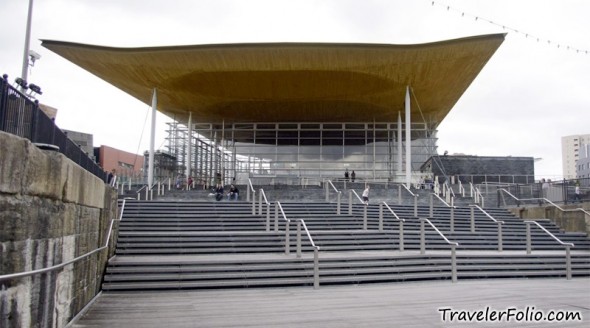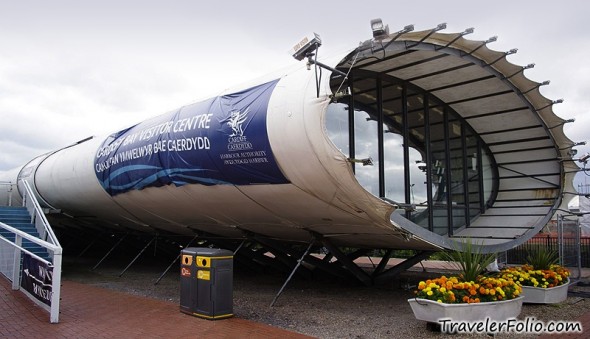
Home to the Welsh national opera and other Wales’ major cultural institutions, the Millennium Centre was opened by the Queen in 2004. Drop in for a free performance that can be jazz, classical, choir or even hip hop at the Glanfa Stage.
Further down, you would come across an intriguing building with a wave-like roof and see-through glass walls overlooking the bay. It’s the Welsh Senedd (Parliament) Building. Through the glass walls, everyone can see a clear view of the debating chamber and this reflects the encouragement of the involvement of public participation. The eco-friendly building incorporates natural ventilation and interestingly, when the locals express that it allows hot air to be drawn out of the debating chamber, you know it can be synonymous with heated debates!
Back in the olden days, seafarers and immigrants from across the world settled near the bay and the population grew. The bustling scenes of port activities were long gone and replaced by holiday-makers relaxing around the bay. Nonetheless, the modern Cardiff Bay still retains the old charm that speaks of its glorious past as a major coal exporter to the world in the 19th century. Established in 1897, the Pierhead still stands elegantly at the waterfront. Originally the headquarters of the Cardiff Railway, the red terracotta building of French-Gothic Renaissance theme is now a Welsh history museum and exhibition centre. It’s affectionately known as the “Baby Big Ben” of Wales. In the foreground, the sculpture of a face combines with a ship hull is the Merchant Seafarers War Memorial that commemorates the seamen of Cardiff who perished during World War II.
Did you know that the world famous author Roald Dahl was born in Cardiff? He was christened in the former Norwegian Sailors Church, presently known as the Norwegian Church Arts Centre that holds exhibitions, concerts and events. To try some Norwegian flavours, dine in the centre’s coffee shop that offers a range of food and drinks.
The old lightship Helwick LV14 is a floating chapel for worship and doubles as a tourist attraction where visitors can tour the vessel and enjoy refreshments with a bay view.
To get tourist information, souvenirs and understand more about Cardiff through videos, exhibitions and interactive displays, look for the “squashed toilet roll” structure. Locally known as “the Tube”, the design of the visitor centre is so “unconventional” that I nearly missed it!
There are plenty of shops, restaurants, bars and cafes at the Mermaid Quay. Stroll along the boardwalk and greet the People Like Us. The bronze sculptures reflect the diverse culture and attributes of the world major coal exporting port in the olden days.
The Celtic Ring on the boardwalk with tidal charts, maritime instruments and docks indicated on its bronze surface.
If time permits, drop by Doctor Who permanent exhibition at the Red Dragon Centre in Cardiff Bay where you can find props, costumes and monsters featured in the latest series. Cardiff is home to Doctor Who, a science fiction TV series filmed in the city. Open 7 days a week till 6.30pm. An adult’s ticket costs £6.50; a child’s ticket costs £5.00.
We travelled to Cardiff Bay by the bendy bus and decided to take a different route to Cardiff Castle at the city centre by Aquabus, Cardiff’s water transport service. The designated waterbus departs hourly from Mermaid Quay to Cardiff Castle and a single adult trip costs £3 and £5 for a return trip. Kick back and enjoy the smooth sail along River Taff with a whiteness of swans swimming graciously in the waters.
Cardiff Castle sits in the heart of the cosmopolitan city. Very deep in history, it’s the leading heritage attraction in the centre and you shouldn’t miss it. Well, you can’t miss it too! Remember I mentioned in my previous post that it’s just right across the road of Hilton Hotel where we stayed? The medieval Castle was originally constructed as a Roman fort and evolved into a variety of architectures over a period of 2000 years. It was refashioned into a neo-Gothic castle in the 19th century by the 3rd Marquess of Bute and the renowned Victorian art-architect, William Burges. In 1947, the 5th Marquess of Bute presented Cardiff Castle to the city.

Admission fee to enter the castle is £10.50 for an adult and £7.95 for a child. This includes an audio guide (with several language options) of Castle grounds, Norman Keep and Battlement walk; entry to some Castle apartments; Cardiff Castle Museum of the Welsh soldier; the Interpretation Centre with exhibition and film show.
Note: If you wish to join the 45-minute guided tour, arrive at the Castle before the tour starts at 1.40pm. The premium tour adult ticket costs £13.50 and £10.00 for a child. The premium tour will include additional Castle apartments with a guide.
Make an easy climb up to the Norman Keep for a panoramic spectacle of the ancient Castle grounds and buildings in juxtaposition with the urbanized city. The 12th century Keep used to serve as a secure residence for the lord and his household as well as a prison and armoury. Look out for the iconic Millennium Stadium with four huge masts. Featuring a 72,000-seater capacity with a fully retractable roof, the famous sporting arena will host football competition in the London 2012 Olympics.

Adjourn to the Castle apartments to appreciate the opulent interiors and be awestruck. Highlights include the Library with a red and gold canvas adorning the walls and intricately carved furniture produced by Lord Bute’s own workshops, as well as the Arab Room with a stunning interior of Egyptian-inspired stained glass windows and Italian marble walls and floor. The medieval-themed Banqueting hall decorated with murals is the impressive centerpiece of the castle built to accommodate Lord Bute’s guests.
Subscribe to:
Post Comments (Atom)
tourist999.blogspot.com. Powered by Blogger.
0 comments:
Post a Comment